Field Visit & Study Trip
An Immersive Experience: Van Gogh’s Masterpieces
Date: 06 August 2025
The Department of English under the School of Humanities and Social Sciences at Kristu Jayanti University, Bengaluru, organized a unique educational event titled "An Immersive Experience: Van Gogh's Masterpieces" on August 6, 2025, at 10:00 AM. The event took place at the Van Gogh Exhibition Center, located in the Bhartiya Mall of Bengaluru, and was exclusively curated for the students of BA and MA English. This immersive exhibition allowed students to experience the legendary works of Vincent van Gogh through augmented reality, offering a dynamic and interactive approach to visual art. The initiative aimed to bridge the gap between literature and visual culture by providing students with a firsthand encounter with Van Gogh’s iconic style and emotionally charged compositions. Featuring well-known works like “Sunflowers,” the exhibition invited reflections on themes such as beauty, impermanence, and emotional expression—parallels often explored in English literature. Through this experience, students not only enhanced their understanding of art but also gained deeper insight into the interdisciplinary connections between visual aesthetics and literary studies. The Department of English continues to champion innovative learning experiences that integrate technology, creativity, and cultural appreciation, reaffirming its commitment to holistic and experiential education.
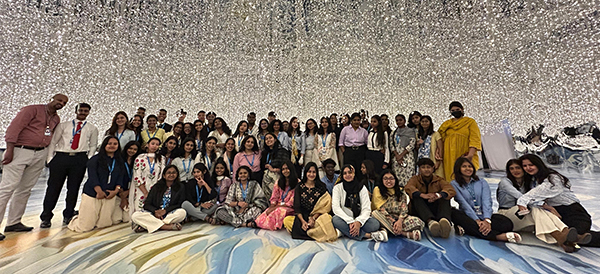
An Immersive Experience: Van Gogh’s Masterpieces
Date: 24 July 2025
The Department of English, Kristu Jayanti Deemed to be University, Bengaluru, organised an educational visit titled “An Immersive Experience: Van Gogh’s Masterpieces” on 24 July 2025 for the students of II BA and II MA English. The event was held at the Van Gogh Exhibition Center, located in Bhartiya Mall of Bengaluru, and featured an Augmented Reality exploration of Van Gogh’s iconic artworks.
The exhibition offered students an innovative and interactive journey through the life and works of Vincent van Gogh, with digital projections, immersive storytelling, and AR-enhanced visuals that brought the artist’s masterpieces to life. Among the highlights was The Starry Night, which captivated the students with its vibrant textures and emotional depth when experienced in augmented reality.
This immersive art experience allowed students to engage with visual culture and art history in a dynamic and memorable way, connecting literary interpretation with visual expression. The event enhanced their understanding of artistic movements and provided valuable insights into the emotional and psychological contexts of Van Gogh’s work.
The visit proved to be a visually enriching and intellectually stimulating experience, reinforcing the Department's commitment to interdisciplinary learning and experiential education.
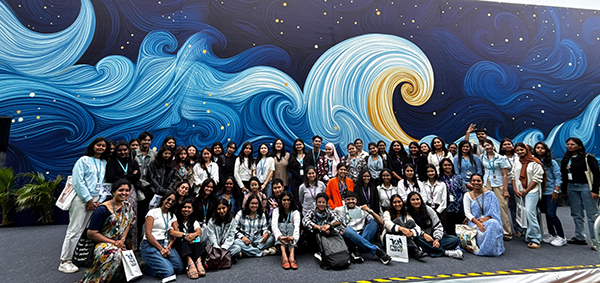
Experiential Visit to Channapatna and Janapada Lok
Date: 23 April 2025
The Department of English at Kristu Jayanti College organized an Experiential Visit for the II Semester English Literature students to Channapatna and Janapada Lok on April 23, 2025. A total of 18 students participated in the visit, which aimed to offer them exposure to the rich culture and traditions of the region. The visit to Channapatna, renowned for its traditional wooden toys, allowed students to witness the intricate craftsmanship and understand the historical significance of local art forms. At Janapada Lok, students explored various exhibits showcasing Karnataka’s folk heritage, traditional attire, musical instruments, and lifestyle practices. The session was highly engaging, encouraging students to interact with artisans and appreciate the diversity of indigenous traditions. This experiential learning opportunity not only enhanced their cultural understanding but also offered insights into how local narratives contribute to the broader field of literature and cultural studies. Overall, the visit was enriching and inspiring.
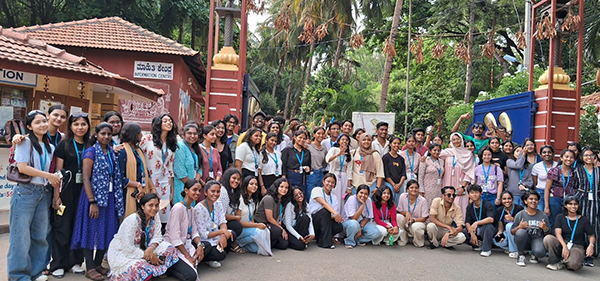
Experiential Learning Field Visit
Date: 05 April 2025
The Department of English conducted a field trip for the students of I MA English as part of the course "Theory, Society and Culture" on 5th April 2025. The students visited Mysore Palace, Payana Car Museum, and Ranganathittu Bird Sanctuary. Through structured activities, students explored cultural heritage, historical significance, and socio-economic aspects of the region. Observations and interactions at each site enriched their academic understanding and practical insight. The trip was conducted smoothly with all safety measures in place, and students remained under strict supervision throughout. The trip provided an immersive, interdisciplinary learning experience that successfully reinforced classroom concepts through real-world observation.
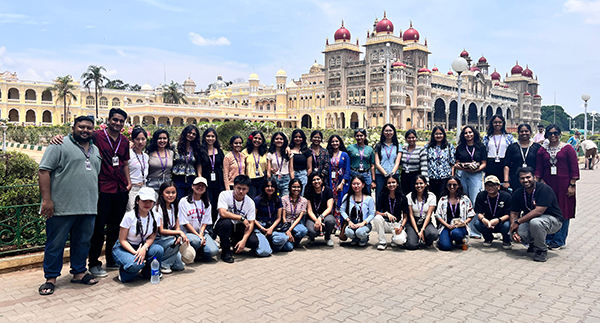
Experiential Learning Field Visit
Date: 04 April 2025
On April 4th, 2025, 22 students of IV Joen, guided by Dr. Aryamol K. P, visited Janapada Loka and Bharath Art and Craft Factory in Channapatna as part of their course on Gender Studies and Popular Culture. At Janapada Loka, students explored curated representations of tradition through cultural artifacts and architecture. In Channapatna, they observed changing gender roles in the doll-making industry, particularly the growing involvement of women. The visit highlighted how popular culture reshapes traditional crafts and how gender sensitization influences long-standing practices. This field visit provided valuable insights into cultural evolution, gender dynamics, and artistic expression, fostering critical engagement with issues of identity, labor, and the preservation of regional heritage in modern contexts.
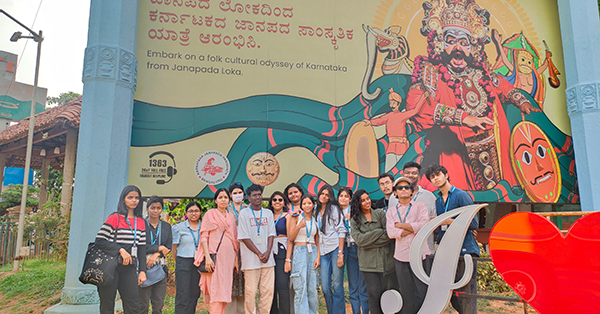
Field Visit to Channapatna and Janapada Loka
Date: 04 April 2025
As part of the curriculum for the subject Gender Studies and Popular Culture, students of BA English Literature undertook a field visit to Channapatna and Janapada Loka, guided by Dr. Jithin Joseph. The visit included the Bharath Art and Craft Factory, its Showroom and Painting Unit, and Janapada Loka.
Students explored gender roles within the traditional doll-making industry, observing the increasing participation of women and how gender sensitization is reshaping long-held practices. They also studied how popular culture is influencing the aesthetics of this 400-year-old tradition.
At Janapada Loka, students engaged with curated representations of regional heritage through artifacts and architecture. The visit offered a rich, experiential understanding of the intersections between gender, culture, and popular art forms.
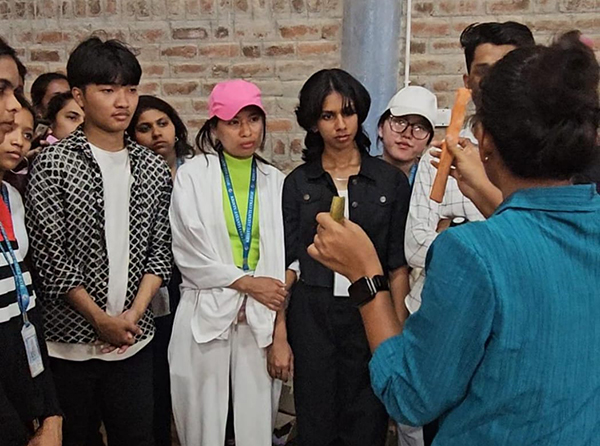
Industrial Visit National Translation Mission (NTM)
Date: 30 October 2024
As part of the BA Final year curriculum for the PYEN batch, a field trip was organized with the objective of enhancing students' understanding of translation's critical role in preserving and promoting linguistic diversity in India. The visit to the National Translation Mission (NTM) in Mysore offered a firsthand look at the workings of this government initiative, which is responsible for translating India's 22 scheduled languages.
During the visit, Dr. Tariq Khan, Officer in Charge, and Dr. Jananamuthy, Kannada Translator, provided an overview of NTM's mission, the importance of translation for accessibility and cultural preservation, and the methods NTM employs to keep pace with changing linguistic trends. They discussed the challenges involved in translating classical texts and contemporary content and addressed students' questions in an interactive Q&A session.
Prof. Jerrin Jose, Dr. Mary Raymer, and student representative Ms. Harshini expressed appreciation to the NTM coordinators, who played an instrumental role in organizing this educational visit. The students toured NTM's library, where they explored a vast array of translated works, reinforcing the importance of language accessibility in a multilingual society.
To extend their learning about cultural heritage, the students visited Mysore Palace, gaining insight into historical preservation and the significance of heritage conservation. The trip concluded with a visit to the Sri Chamarajendra Zoological Gardens, providing an enjoyable and educational experience in environmental awareness.
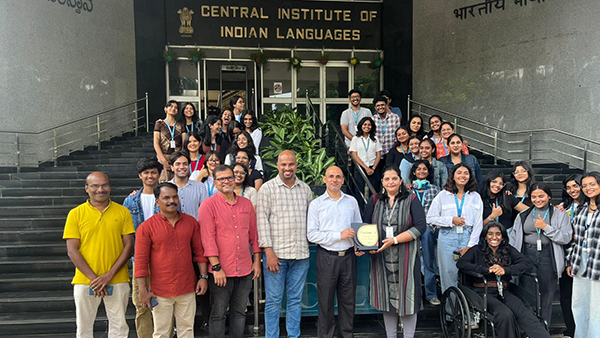
Industrial Visit to Viveka Tribal Centre for Learning
Date: 02 March 2024
On the 2nd of March 2024, students filling two buses along with teachers began their journey to the Viveka Tribal Center for Learning, Hosahalli at 6 am. The center was lively with the resounding voices of the children accompanied by their teachers. One could notice them walking barefooted even in the blazing sun. When questioned about the same they mentioned that they were accustomed to the practice. It shows the physiological connection that they have with the place they call home and school. The children live away from their parents and are provided for by the institution which is an NGO. The NGO is funded by Titan. The food prepared for the children was with the vegetables that they grew themselves showing their immense connection with the land and culture.
While visiting the school we were privileged to see their labs consisting of the latest methods of teaching including gaming modules of CPU and processors for the computer lab. The teaching process also included major life skills such as mechanical and electrical training and tailoring. This would help provide a livelihood for the students in the future if they didn’t wish to pursue higher education. However, there were provisions made for the students to take up higher education and college degrees if they were academically inclined. They also gave importance to sports and athletic activities. The students were overjoyed to have us as their visitors and made conversation. They wished for us to come more often.
The students also mentioned that they were taken on recreational activities to the nearby cities, hence the center provides a holistic development and a nurturing environment for the students. We also became aware of the need for more teachers and workers for the betterment of such centers and donations for the same. Students were grateful for the insightful opportunity.
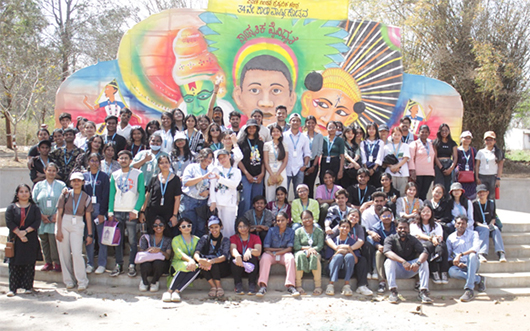
Industrial Visit to Mysore
Date: 01 March 2024
The students of first year English Literature students and JOEN (Journalism and English Literature) embarked on a memorable journey to Mysore on 1st March 2024 for the Industrial Visit. The gathering visited several places in Mysore including St. Philomena’s Cathedral, Mysore Palace, and Ranganathittu Bird Sanctuary.
As part of the experiential learning trip, the students learned a lot about the incredible architecture and history behind the places visited. St. Philomena’s Cathedral was built by the Maharaja of Mysuru Mummudi Krishnaraja Wadiyar in 1843 in memory of the 4th-century saint and martyr St. Philomena. The Cathedral was built as a gift to a large number of European populations residing in Mysuru in the 19th century. The mesmerizing architecture left everyone amused and the group thoroughly enjoyed themselves while learning about the significance of the Cathedral.
Mysuru Palace was built in the early 14th century by the royal family of Wodeyars. Mysuru palace was originally built of wood and was destroyed once by lightning (in 1638 AD), by Tipu Sultan (in 1739 AD), and once again by fire in 1897 AD. Current Mysuru Palace is the fourth reconstruction, completed in 1912 and designed by British architect, Henry Irwin. The grand palace had a royal feel and left everyone starstruck. The interior of the palace was beautifully decorated, leaving every person speechless. The group learned a lot about the history of the palace through the several paintings presented in the palace and the architecture was simply magnificent.
The Ranganathittu Bird Sanctuary was established as a sanctuary in 1940 at the request of renowned ornithologist Dr. Salim Ali. It is a haven for those who enjoy the outdoors and bird watching. Situated on the banks of the River Cauvery, the sanctuary occupies an area of 0.67 square kilometers. Many of the local bird species choose to nest in this bird paradise. The sanctuary was filled with bird calls and helped everyone relax. The beautiful sanctuary was filled with greenery and beautiful birds which was very pleasant. The students also embarked on a boat ride where they saw an enormous crocodile while it was asleep.
The students thoroughly enjoyed the learning experience with a close connection with nature beside the classroom teaching learning process.
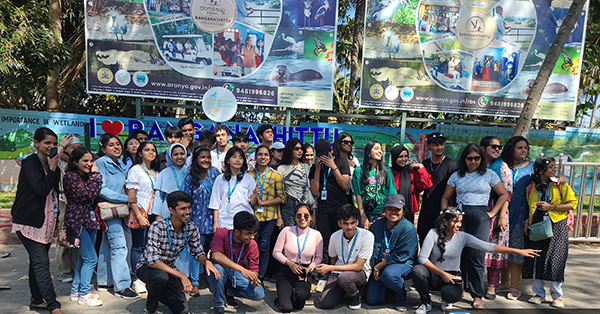
Field Visit to National Translation Mission, Central Institute of Indian Languages, Mysore
Date: 27 September 2023
As a part of Curriculum, Department of English, Kristu Jayanti College, Autonomous, Bengaluru conducted a field visit for the students of V BA Psychology, English Literature to National Translation Mission, Central Institute of Indian Languages, Mysore. After reaching the institute by 9 in the morning, Students and faculties attended orientation conducted by Mr Jnana Murthy, Resource Person, Kannada, and Dr Aditya Kumar Panda, Resource Person, Oriya on the history, functioning and activities of National Translation Mission. Students were also introduced to various aspects of translation and were given insight about making a career in the field. The nature and scope of Translation Studies were discussed in detail. This was followed by a brief Question-and-Answer session, which proved to be very effective for the students to enquire about the field further and to clarify their doubts and queries. The session ended with the distribution of certificates for participation.

Experiential Visit to Karnataka Chitrakala Parishath
Date: 13 September 2022
An experimental visit was organized by the Department of English on 13th September 2022 for I and II year M.A to the Art Exhibition Karnataka Chitrakala Parishath and National Gallery of Modern Art. The visit aimed to educate the students about the rich art and culture of Western Modernism. The visit was organized under the guidance of Dr. Lyola, Dr. Arsha and Dr. Giftsy. The resource person for the day was Ms. Samyuktha Rao, curator and Art historian. Ms Rao was in charge of escorting the students around the Art gallery, explaining the students about the collection of paintings of Bireswar Sen who is an Indian painter, writer influenced by the Bengal school of Art and Western Modernism. He depicted grand landscapes mostly featuring the Himalayas in paintings measuring smaller than postcards.
In Bireswar Sen’s little paintings of huge landscapes, he has used precisely the skill of attentively studying time and location. Within an infinite amount of space and time, specific moments in time serve as coordinates for the human predicament. The artist helps us grasp the scenes which are dispersed in complex systems of seasonal cycles, mountain upheavals and ancient forests, planets and stars, and constant change. They are characterized by nuanced skies, light-filled clouds, cloud touching peaks that descend into valleys, and high-breasted peaks that rise to the sky.
Next, students visited the National Gallery of Modern Art. The National Gallery of Modern Art has modern, post-modern and traditional Indian art work. It hosts artwork from the 18th Century to present day. It comprises paintings, Sculptures, graphic prints and photography in India which showcase the historical development of modern art in India. The display includes Indian miniatures and works of colonial artists.
Lastly, students went to Cubbon Park. We had feedback sessions and various experiences were shared amongst students. We had a further interactive session with our resource person, Ms Samyuktha Rao. The entire visit was an inspiring experience for the students and for the teachers as well.
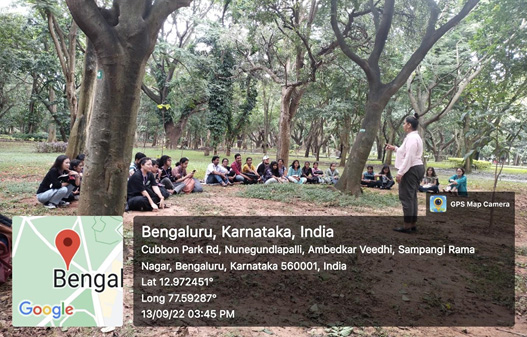
Field visit to Namma Dhwani Community Station, Kolar
Taking the students to Kolar on an educational trip was very useful. They learnt about how a community radio station works and their first field trip from the college just proved to be right, fun and educational. Vishwanatha Reddy V, the station manager provided a detailed explanation on how the radio station was started and talked about the challenges they faced during the pandemic. He also provided how the government funds were used in the development of the radio station and other social works. He also shared about his interest in joining this radio stream developed along with the radio activities they broadcast. The students learnt that the station collaborates with Budikote’s farmers to educate them about agriculture and other farming related topics. Even during the pandemic, the station was operational and they educated people, promoted awareness on the precautions to be taken without hustling about the danger. This was overall a fulfilling experience where the students got to know many important issues, problems, functions of the radio station. They also visited the birthplace of Hyder Ali.
Learning Outcome:
Students were able to master the recording techniques used in a station.
They understood the skills of a professional radio production facility engineer, the performance and all the aspects related to recording.
Feedback: The students found the field trip very beneficial
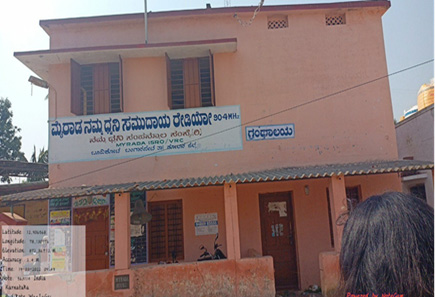
Field visit to Srirangapatana and Mysore
Field trip to Srirangapatana and Mysore was educational and historical. Students were able to understand the cultural and literary aspects of Wodeyar dynasty. The architectural visuals and the golden Howrah were the highlights of the visit in Mysore. Next visit was to St. Philomena’s church which was constructed in 1843 using a neo-gothic style by Mahraja Mummadi Krishnaraja Wodeyar. The last location was Ranganathittu Bird Sanctuary in Sririangapattana is the largest bird sanctuary in the state. More than 30 different species of migratory birds can be found in the sanctuary.
Learning Outcome:
• Students got an opportunity to know about the Wodeyar dynasty and its ruling
• Students were able to analyse the literary, cultural and political growth of the city
• Students were able to learn about the neogothic style and the rulers of Mysore Kingdom
Feedback:
Student’s feedback was taken through feedback forms. Students enjoyed the experience of knowing the cultural and historical aspects of Mysore. The trip was well organized and students were satisfied with the knowledge and coordination with others through the visit.
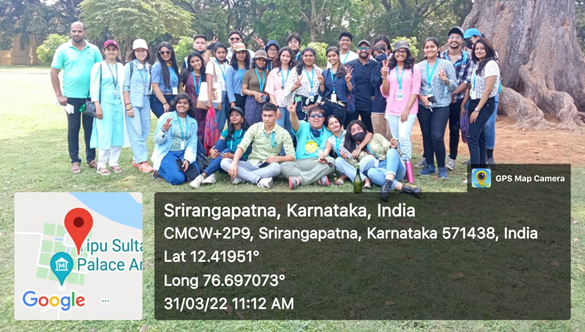
Field visit to Community Radio Station – Kolar
On the 5th of March 2022, the students of IV Sem JPEng A and JPsEng visited the Community Radio station called ‘Namma Dhwani’ which is situated at Budhikote, Bangarpet Taluk, Kolar district. The concept of Namma Dhwani was visualized by MYRADA and VOICES (Communication Expert NGO). It began Narrowcasting earlier in 2008 in two villages and now it has grown to cover 152 villages within a 12 km radius in 2 taluks. It was a great learning experience for the students as they witnessed certain concepts related to the community radio through practical exposure. They learned about the recording processes, content delivery, and many other concepts related to Radio. They were also exposed to scripting and about the importance of choosing stories that would cater to the audience’s needs.
Learning Outcome: The students were able to record and produce content based on Women’s education and Women’s health. They had hands-on experience by recording with microphones which went on air in the later week. They were also introduced to scripting, arranging programme schedules and the concept of archiving, and how they’d be able to come up with past content. The students themselves hosted certain programmes and also became interviewees by sharing their experiences and talking about the importance of Health, Education and Women’s Empowerment. At the end of the programme, the students were certified by the station for their active participation.
Feedback: The trip was great practical exposure for us journalism students. The trip showed us how a radio station works. We went to a local/small radio station in Kolar, we studied the struggles and achievements of the workers. We also understood the impact of radio on their surroundings. The teachers and head of the radio station were helpful, cleared all our doubts, and encouraged us to explore the station. The trip was short, organized, and a great experience. – Apoorva Sharma, IV Sem JPEng A
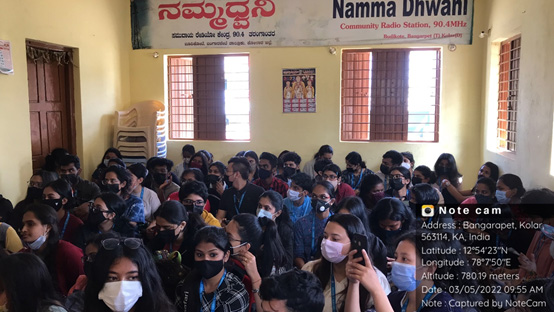
Field visit to Shravanabelagola
The field visit to Shravanabelagola, Rural Karnataka, India was a remarkable trip for the whole class. With its blissful sight, it is known as one of the most iconic places consisting of 2 hills. The students climbed 700 steps to see the most breath taking view, having great Bahubali statue which was 58 feet tall. We climbed 250 steps more towards other famous and beautiful temples which had around 17 idols in it. Students got to know the rich culture which is being followed by the villagers of Shravanabelagola and its mesmerizing history and maintenance of the place.
Shravanabelagola is an important Jain pilgrimage Centre in South Karnataka. It is home to the 18 m high statue of Lord Gometeshwara; considered to be one of the world’s tallest free-standing monolithic statues. Constructed in 981 AD by Chamundaraya, a Ganga warrior, it is carved out of a single block of granite and looms on the top of Vindhyagiri Hill. It is visible up to 30 km away. There are nearly 700 steps hewn in the rock-face which must be climbed to have a close-up view of this colossal magic.
It is important to remember what ‘1000 years ago’ means: it is the time when the regional languages and scripts of India were just emerging, when Islam had not impacted life in India, when Shankaracharya had written his commentary on Vedanta, but not Ramanuja, or Madhwa. The Tamil Alwar and Nayanar poetry was just being composed, the Bhakti movement was just emerging, and much of South India was under the influence of Jain, and Buddhist doctrine.
Altogether they gained information on the history of architecture and its moral values.
Learning Outcome:
• Students were able to learn the emergence of religious script in regional language
• They were able to connect with the subject they study esp the Bhakti movement and its writings
• They were also able to know the renunciation of Jainism
Feedback from Students
The field trip was innovative and informative for all of us. Shravanabelagola (Sravaṇa Belagola) is a town located near Channarayapatna of Hassan district in the Indian state of Karnataka and is 144 km from Bengaluru. The Gommateshwara Bahubali statue at Shravanabelagola is one of the most important tirthas (pilgrimage destinations) in Jainism, one that reached a peak in architectural and sculptural activity under the patronage of Western Ganga dynasty of Talakad. Chandragupta Maurya is said to have died here in 298 BCE after he became a Jain monk and assumed an ascetic life style. Gommateshwara statue, Akkana Basadi, Chandragupta basadi, Chamundaraya Basadi, arshvanath Basadi and inscriptions of Shravanabelagola group of monuments are listed as Adarsh Smarak Monument by Archaeological Survey of India. Hence, we all were able to learn and understand the rich architectural monuments of our country. (Amrita Shibu, 19HU6A1006)
Hailing from Kerala, to see so many deities up close was definitely one for the books. I also witnessed many inscriptions and the gigantic stone placements which cannot be seen in everyday scenes. The hill we climbed on was the Vindhyagiri hill where the popular Gommateshwara Bahubali was in all its glory. I underestimated its magnificence until I got the chance to stand next to it. To say the least, being an adventurer myself, this trip was fun especially since it was my last undergraduate field trip with all of my friends. (Jibin Johnson 19HU6A1019)
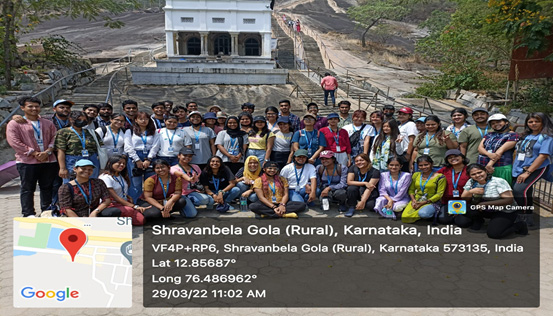
Field visit to Somanathapura Temple & Janapada Loka
Date: June 08, 2022
The students of BA History, Political Science, and Sociology (II Semester HSPS, HSEC, PSEN, PSEC, & PSSO) visited Somanathapura temple & Janapada Loka on June 08, 2022 as part of their practical curriculum study. The students visited Somnathapura temple where they witnessed stone carved temple with inquisitive incurved designs with three deities inside the temple. At Janapada Loka, the students got to see ancient artifacts which give insights to the rich diverse cultural heritage of Karnataka. The field visit was a great learning experience.
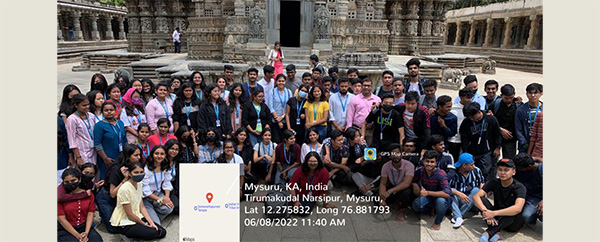
Date: 10th January 2020
Class & No. of students: VI BA JPENG B 51
Places Visited: Japapada Lok
Name and details of any external agencies/contacts involved: No
Japapada Loka (Folk World) was established on 21 March 1979 by H. L. Nage Gowda and it is located in Ramanagara District, Karnataka on the Bangalore Mysore highway. It is a folk museum that has an exclusive collection and display of the village folk arts of Karnataka. Apart from museum there are statue of Yakshagana, Veergase artists and also sculptures of working man and women who are engaged in various work in a village set up. This place truly promotes the hardcore folk and folk forms of Karnataka for the future generation.
Learning Outcome:
1. Students got an opportunity to expose themselves to the folk of Karnataka
2. This gave them an opportunity to analyze and compare their own folk culture with Karnataka Folk.
Feedback:
Student’s feedback was taken through feedback forms. To mention the in brief students tharoly enjoyed the experience of knowing Karnataka folk. This enhanced their knowledge on folk as medium of communication.
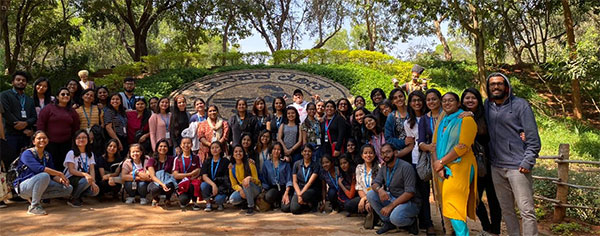
Date: 7th February 2020
Class & No. of students: VI BA JPENG. 50 Students
Places Visited: 1. Janapada Loka, Ramanagara
Name and details of any external agencies/contacts involved: Janapada Loka, Ramanagara
VI JPENG A batch students visited Janapada Loka, the folk art museum situated in Ramanagara on 7 February 2020. Janapada Loka exhibits the life style of village folk of Karnataka and different types of musical instruments, tools used in agriculture and farming. The shadow puppets on display are 500 years old. Loka Mahal, a wing in the museum has a display of 5,000 folk artifacts. Chitra Kuteera commemorates the museum's founder H L Nage Gowda. Doddamane or "big house" is a replica of a large traditional village house. ‘Ayagaramala’ is an open yard which gave an exposure to the rural lifestyle with sculptures of working man, household and rural utensils.
Objectives:
1. To introduce the folk life, culture and art to the students.
2. To inculcate an interest in folk life, art and culture.
Learning Outcome:
1. Students acquired knowledge about the folk culture of Karnataka
2. Students are capable of critically analyzing and comparing the rural and the urban life art and culture.
Feedback:
1. The trip opened a new frontier of folk life, culture and art to the students.
2. Students should be exposed to more rural life to bridge the gap between rural and urban life. .
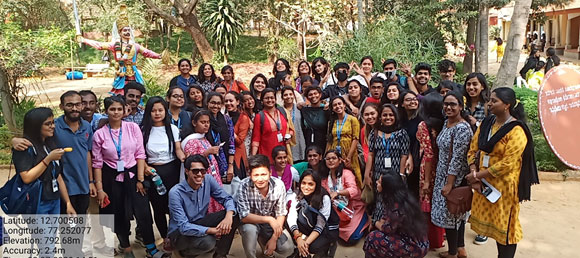
Date: 7th February, 2020
Class: II JPEng B
No. of students: 60
Places Visited:
1. Big Banyan Tree, Tavarekere
2. Janapada Loka, Ramanagara
Name and details of any external agencies/contacts involved: NA
The much awaited field trip was organized on 7th February, 2020. The first place that we visited was the Dodda Aalada Mara literally translated to Big Banyan Tree, located in the village of Kethohalli in the Bangalore Urban district of Karnataka, India. The students were excited to see the giant 400-year-old banyan tree.
The second place we visited was Janapada Loka, which is a folk museum that has an exclusive display of the village folk arts of Karnataka. It is under the aegis of the Karnataka Janapada Parishat. Loka Mahal, a wing in the museum has a display of 5,000 folk artifacts. It is situated in Ramanagara, Ramanagara district in the Indian state of Karnataka. Janapada Loka is divided into separate wings — Folk arts museum, Loka Mahal, Chitra Kuteera, Doddamane, Shilamala, Arghyamala etc. The students were mesmerized with the artifacts used in the 1980s and the culture and customs of the time.
Learning Outcome:
1. We were able to understand the evolution of lifestyle to more modern times.
2. Understand, promote, preserve and propagate the vibrant folk art and culture.
Feedback:
1. Well organized and good experience for the students and teachers alike.
2. Highly recommended place of visit for the students.
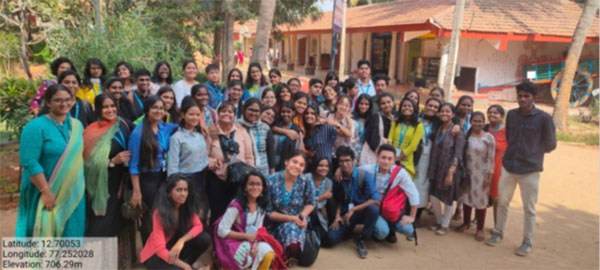
Date: 23/01/2020
Class & No. of students: II BA JPEng, 57 students
Places Visited: Trithwa Ashrama
Name and details of any external agencies/contacts involved: Sr. Elishwamma D E C (Superior, Thrithwa Ashrama)
The students of II semester JPEng‘A’ along with the Class Animator, Dr.Pauline V N, visited Trithwa Ashram, an old age home located in Thanisandra Main Rd, Bengaluru. The class consisting of 57 students along with the Class Animator reached the organization approximately at 2.00 PM and were welcomed by the caretaker of the organization Sr.Elishwamma, a person of unique abilities and mental strength. The students interacted with the inmates and they remembered and shared the memories of their life. The students conducted games, performed and sang in order to engage the old age people with happiness and enjoyment. Students contributed food and snacks for the old age people in the home.
Learning Outcome:
1. The students have experienced the different perspectives of life.
2. This experience helped the students to learn much about the life of those people and the difficulties faced by them due to schizophrenia.
Feedback:
1. Interaction with the inmates turned out to be a great learning experience for the students
2. For many students it was their first experience of being in a place like that which made them feel how blessed they were and encouraged them to lend a helping hand to people in need.
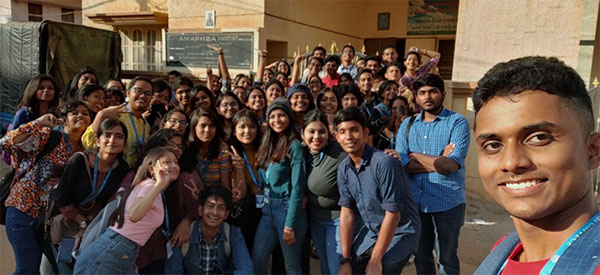
Date: 10/01/2020
Class & No. of students: II BA JEEng, 30 students
Place Visited: Janapada Loka
The students of II semester JEEng along with the Class Animator, A Anusha, visited Janapada Loka, a folk museum that exclusively portrays the village folk arts of Karnataka located in Ramanagara, Bengaluru. The class consisting of 30 students along with the Class Animator reached the organization approximately at 10.00 AM and were guided by the caretakers of the museum, with elaborate description on each folk art and the ancient way of living. The students got a better understanding of the folk arts, culture, tradition and the ancient way of living.
Learning Outcome:
1. The students became aware of the various art forms.
2. The experience made the students understand the difference between their life and the life of their ancestors, and helped them assess the pros and cons of both.
Feedback:
1. The visit made the students cherish the rural India.
2. The beautiful natural atmosphere also made the students realize the importance of preserving the nature.
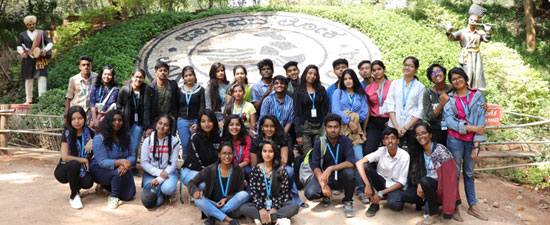
Date: 9th January 2020
Class & No. of students: IV BA JEENG. 26 Students
Places Visited:
1. Big Banyan Tree
2. Janapada Loka, Ramanagara
Name and details of any external agencies/contacts involved:
Janapada Loka, Ramanagara
The class first visited Big Banyan Tree (Ficus Benghalensi), a giant approximately 400-year-old banyan tree located in the village of Kethohalli in the Bangalore Urban district of Karnataka. This single plant covers 3 acres (12,000 m2) and is one of the largest of its kind.
The group then visited Janapada Loka. It means a "Folk world" or "Folk-culture World." It is a folk museum of village folk arts of Karnataka. It exhibits different types of musical instruments, tools used in agriculture and farming. The shadow puppets on display are 500 years old. Loka Mahal, a wing in the museum has a display of 5,000 folk artifacts. It is situated in Ramanagara, on the Bangalore-Mysore highway. Chitra Kuteera commemorates the museum's founder H L Nage Gowda. Doddamane or "big house" is a replica of a large traditional village house.
Learning Outcome:
1. The students learnt about the folk culture of Karnataka
2. It augmented their interest in people and their art.
Feedback:
1. It was a good experience for all the students to be exposed to the rural culture.
2. Some students need to inculcate more interest to bridge the urban and rural life.
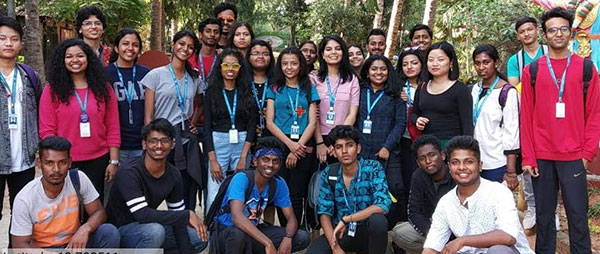
Date: 18.12.2019
Class & No. of students: II MA English Literature - 26 Students
Paces Visited:
1. Karnataka Chitrakala Parishath
#1, Art Complex, Kumarakrupa Rd, Kumara Park East, Seshadripuram, Bangalore
2. National Gallery of Modern Art, Bengaluru
49, GF, Manikyavelu Mansion, Palace Rd, Vasanth Nagar
Name and details of any external agencies/contacts involved: Ms Samyuktha Rao, Art Curator and Artist
The students and two faculty members visited two art galleries to have a first-hand experience of how Literature and Art mimics Life. At times we are confronted by description of exhibits which seem incomprehensible; even an artist’s statement about their work leaves us more nonplussed than enlightened. Thus, this field trip was arranged for our students with a popular artist and a professional curator as our resource person who was able to guide and help them decipher the techniques of Art and Art Curating in the National Gallery of Modern Art and also in the serene environs of Karnataka Chitrakala Parishath.
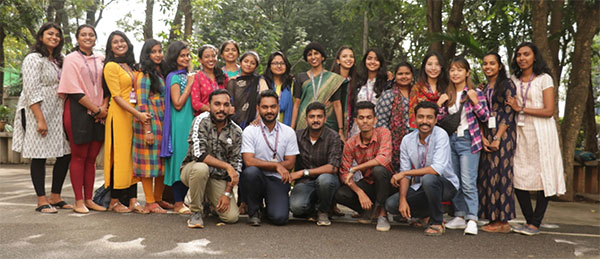
Visit to Karnataka Chitrakala Parishath and National Gallery of Modern Art
A field trip was organised by the Department of English (PG) Kristu Jayanti Colleg for the students of MA I and MA II, under the guidance of Dr. Arpita Ghosh and Dr. Lyola Thomas. It was a one day field trip on December 18, 2019 to Karnataka Chitrakala Parishath and National Gallery of Modern Art as an Experiential Learning Programme. The purpose of the field trip was to observe the different art forms and connect it with the different aspects of life.
The trip was accompanied by art curator Miss Samyuktha Rao, an artist and a sculptor, who was the resource person for the day who enlightened the students about the emergence and importance of different kinds of art forms. Both the art galleries Karnataka Chitrakala Parishath and National Gallery of Modern Art contained a number of spectacular paintings and sculptures. Karnataka Chitrakala Parishath comprised of art forms by famous artists such as Nicholas Roerich, S.S. Kukke, Svetoslav Roerich and number of unnamed Indian artists, whereas, The National Gallery of Modern Art encompassed the art forms from the 19th and 20th century artists like Rabindranath Tagore, Abanindranath Tagore, Gaganendranath Tagore, Nandalal Bose, Jamini Roy, Prabudhha Dasgupta and many other Indian artists. The different art forms are shared by the National Gallery in Delhi and Mumbai.
There were different forms of art which could be seen in the galleries such as – Folk paintings,Varisha Collection, Tanjavore and Mysore Painting, oil paintings and photograph gallery, different kinds of puppets, sculptures made of bronze, wood and charcoal. Each art work reflected layers of stories and inspiration behind it – mythological as well as personal. It also showed the then conditions of the society. The art forms also gave an insight on the different aspects of life during the past years when the artefacts were curated.
There were 48 enthusiastic participants who went for the field trip and experiential learning. The field trip was very informative as we came to know about the importance of literature in the field of art. It was also very useful as each art form displayed various anecdotes, realities and conditions of the past as well as the present society.
“I found the trip very enriching. It has expanded my perspective on different art forms. I also gained new knowledge” expressed Tallo Mary, a second year MA student.
“The tour of the Art gallery was an amazing exposure. As literature students we could relate each art to distinct movements. I had an amazing time seeing various artists and the progression of art. The trip was informative and an amazing experience!” exclaimed Keziah Grace Shibu, a first year MA student.

EXTENSION ACTIVITY
Class and No. of students: I MA English Literature: 26
Date: 21.03.2019
Objective: To appreciate the Art and Architecture of the ancient city of Hampi.
The Department of English (PG) organized an Extension Activity for the students of I MA English Literature on March 21, 2019 under the guidance of Dr. Lyola Thomas and Dr. Paulami. The Extension Activity took place at Hampi, Bellary District. The main purpose of the visit was to employ Literature as a tool to capture and interpret a personal experience to the world in the form of Travelogues, Creative Writing and Fictionalising Personal Experience. The Extension Activity was very helpful to the students of I MA Department of English (PG) as they could employ more authentic art and life experiences in their writings. This was a great privilege and an enriching experience as they were able to witness History carved in stone and also because Creative Writing is a part of the syllabus this semester. We thank the Department of English (PG) for initiating and organising the Extension Activity. It was a golden opportunity for us because we were able to experience innumerable sources of inspiration – the driving force behind all forms of writing.
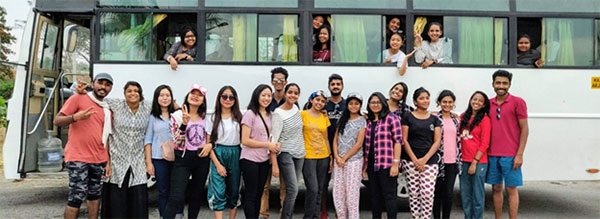
RURAL EXPOSURE
Class and No. of students: I MA English Literature: 26
Date: 20.03.2019
Objective: To gain access a first-hand understanding and experience of the social community of a village and to experience the fabric of Indian village life in its truest form.
The Department of English (PG) organized a Rural Exposure for the students of I MA English Literature on March 20, 2019 under the guidance of Dr. Lyola Thomas and Dr. Paulami. The Rural Exposure was in Hubli. The students also visited the Government Higher Primary Kannada Girls High School at Hepsur, Hubli-Talia, Dharwad District Karnataka. The students conducted English classes for the students in the Government School. The main purpose of the visit was to impart communicative skills in English to the students there. The MA students were divided into several groups and they visited different classes in the government school. Students of the primary classes were taught about the importance of Health, Hygiene, and Good Habits. Language games were also conducted and the students participated actively displaying a keen interest in learning. This teaching experience was helpful not only to the village students but also to the PG students of the Department of English (PG) because all of them were engaged in the teaching experience in different ways and they also used various methods for teaching giving them valuable practical experience. The Rural exposure thus was very inspiring and the objective of the activity was more than met. We thank the Department of English (PG) and the College for initiating and organising the Rural exposure programme. This was really a golden opportunity for us and an unforgettable experience.
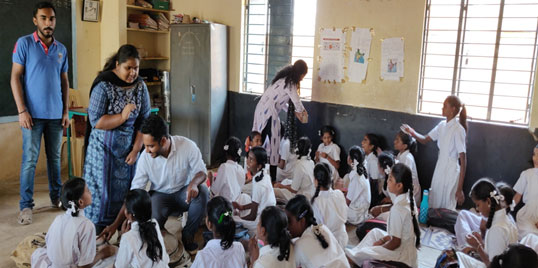
Field Visit – Rural Exposure program
Department of English in Kristu Jayanti College along with the students of IV semester MA in English literature had organized a rural exposure program on the 11th December 2017; the places were Karahalli and Sagarahalli villages which belong to the rural part of Bengaluru. . The objective of the program was, to correlate our theoretical knowledge of Subaltern Literature with the practical aspects of village life and to understand the essence of rural expertise and dignity of labor.

